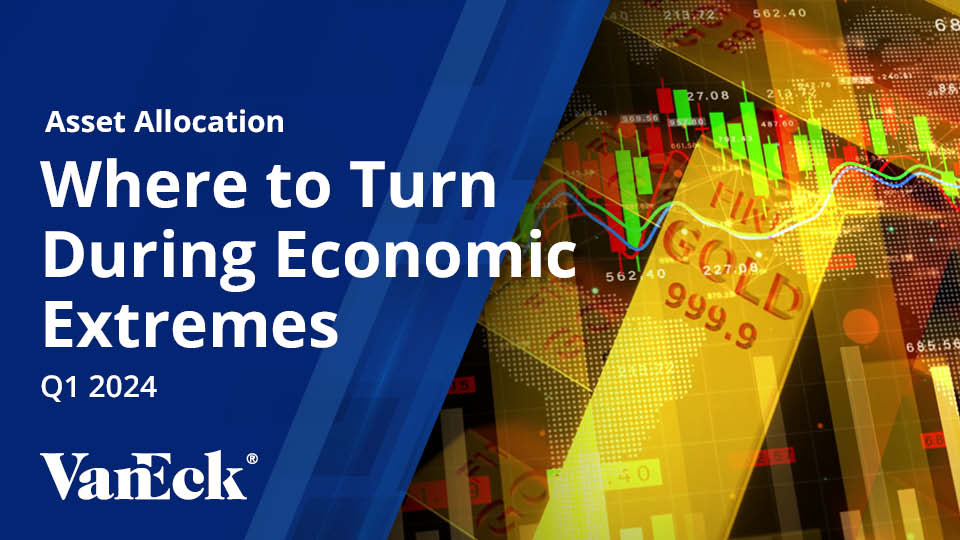RAAX Evolves with Bitcoin
February 18, 2021
Read Time 5 MIN
The VanEck Vectors® Real Asset Allocation ETF (RAAX®) uses a data-driven, rules-based process that leverages over 50 indicators (technical, macroeconomic and fundamental, commodity price, and sentiment) to allocate across 12 individual real asset segments in five broad real asset sectors. These objective indicators identify the segments with positive expected returns. Then, using correlation and volatility, an optimization process determines the weight to these segments with the goal of creating a portfolio with maximum diversification while reducing risk. The expanded PDF version of this commentary can be downloaded here.
Overview
The VanEck Vectors® Real Asset Allocation ETF (“RAAX”) returned 7.21+% versus +2.63% for the Bloomberg Commodity Index. January started off strongly, RAAX was up 5.39% mid-way through the month, but it gave back much of this performance to finish the month with a total return of 1.24% as fears of dangerous COVID-19 mutations weighed upon the market.1
RAAX invests in three types of real assets: financial assets, income assets and resource assets. RAAX evolved and diversified its financial assets in February by gaining exposure to the price of bitcoin. This was accomplished with an initial investment of 2% into the Grayscale Bitcoin Trust. We believe that digital assets may offer RAAX many of the same benefits as gold. Most notably, protection against inflation and currency debasement in addition to overall portfolio diversification.
The rally in real assets continued into December as investors continued to weigh the near-term risks of inflation. RAAX has been a huge beneficiary of this change in sentiment because of the ability of real assets to hedge against inflation. Regardless of where you stand on the “great inflation debate”, it seems unwise to ignore this risk and fail to position your portfolio accordingly.
| Average Annual Total Returns (%) as of January 31, 20211 | ||||
| 1 Mo† | YTD† | 1 Yr | Life | |
| (04/09/18) | ||||
| RAAX (NAV) | 7.21 | 7.21 | -5.35 | -0.97 |
| RAAX (Share Price) | 7.40 | 7.40 | -5.13 | -0.92 |
| Bloomberg Commodity Index* | 2.63 | 2.63 | 7.31 | -1.88 |
| Average Annual Total Returns (%) as of December 31, 20201 | ||||
| 1 Mo† | YTD† | 1 Yr | Life | |
| (04/09/18) | ||||
| RAAX (NAV) | 0.44 | -13.73 | -13.73 | -3.50 |
| RAAX (Share Price) | 0.18 | -13.72 | -13.72 | -3.51 |
| Bloomberg Commodity Index* | 4.97 | -3.12 | -3.12 | -2.86 |
The table presents past performance which is no guarantee of future results and which may be lower or higher than current performance. Returns reflect temporary contractual fee waivers and/or expense reimbursements. Had the ETF incurred all expenses and fees, investment returns would have been reduced. Investment returns and ETF share values will fluctuate so that investors’ shares, when redeemed, may be worth more or less than their original cost.
1Source: Bloomberg. Please note that the returns include the reinvestment on January 5, 2021 of a distribution that occurred on December 29, 2020. Please visit our website at https://www.vaneck.com/us/en/resources/tax-and-distributions/etfs/ for additional information.
†Returns less than a year are not annualized.
Expenses: Gross 1.35%; Net 0.78%. Expenses are capped contractually at 0.55% through February 1, 2022. Expenses are based on estimated amounts for the current fiscal year. Cap exclude certain expenses, such as interest, acquired fund fees and expenses, and trading expenses.
The asset allocation mix heading into this month is below:
RAAX Asset Allocation Across Financial, Income, and Resource Assets (as of February 2, 2021)
The largest contributors to performance in January were resource assets, with a return of +3.15%, and income assets, with a return of +0.94%. The largest detractor from performance was financial assets, with a return of -3.32%.
Total Return and Contribution (January 2021)
Data as of January 31, 2021. Source: FactSet. Past performance does not guarantee future results. Please see index descriptions in Disclosure.
Within resource assets, diversified commodities and natural resource equities returned +3.21% and +3.34%, respectively. Commodity prices were led higher by oil prices, with WTI crude oil up 7.30%. Oil prices continue to rise based on supply constraints and optimism of increased economic demand in the second half of the year. Within natural resource equities, the top contributors to performance were traditional and sustainable energy. Oil equities increased based on higher oil prices and sustainable energy continued to benefit from energy transition. The largest detractor from performance was an allocation to steel equities. Some steel companies were negatively impacted by lower demand and rising material costs.
Resource Assets: Total Return and Contribution (January 2021)
Data as of January 31, 2021. Source: FactSet. Past performance does not guarantee future results. Please see index descriptions in Disclosure.
The income assets, in aggregate, are yielding +3.99% based on 12-month yields. The top performing position was MLPs, up 3.98%, which benefited from higher oil prices. The largest detractor was infrastructure, with a return of -2.47%. Infrastructure was negatively impacted by COVID concerns, with airports hit particularly hard.
Income Assets: Total Return and Contribution (January 2021)
Data as of January 31, 2021. Source: FactSet. Past performance does not guarantee future results. Please see index descriptions in Disclosure.
The financial assets were the largest detractor from performance. Gold bullion returned -3.11% and gold equities returned -4.19%. Gold started the month off strongly, but the excitement for the shiny metal quickly faded when the Democrats took control of the U.S. Senate in early January. This result makes generous stimulus all that much more likely, which quells market anxiety and lessens the demand for gold as a safe-haven asset.
Financial Assets: Total Return and Contribution (January 2021)
Data as of January 31, 2021. Source: FactSet. Past performance does not guarantee future results. Please see index descriptions in Disclosure.
Real assets continue to benefit from fears of inflation and hopes of higher global growth in the second half of 2021. The recent positive trends in commodity prices offer much relief to an asset class that has struggled to perform since the financial crisis. Now that the tides are turning, commodities and other real assets have the potential to lead the market higher for many years to come.
The chart below shows the real asset risk composite that measures extreme risk within real assets using various quantitative signals. The current score is 12, which indicates a stable risk regime for real assets.
Overall Risk Score
The charts below demonstrate the current, previous months and recent shifts in RAAX’s asset allocation. The recent shifts include reductions in agriculture and traditional oil equities and increases in exposure to sustainable energy and a new position in a vehicle that provides exposure to the price of bitcoin.
Asset Allocation Summary
Monthly Asset Class Change
| Feb-21 | Jan-21 | Change from Previous Month | ||
| Financial Assets | ||||
| Bitcoin | 2.1% | 0.0% | 2.1% | Increase |
| Gold Equities | 4.9% | 5.4% | -0.5% | Decrease |
| Gold Bullion | 20.0% | 20.8% | -0.8% | Decrease |
| Income Assets | ||||
| REITs | 14.5% | 13.6% | 0.9% | Increase |
| MLPs | 5.2% | 5.1% | 0.1% | Increase |
| Global Infrastructure | 4.9% | 5.0% | -0.1% | Decrease |
| Resource Assets | ||||
| Low Carbon Energy Equities | 8.1% | 6.8% | 1.2% | Increase |
| Diversified Commodities | 20.5% | 20.1% | 0.4% | Increase |
| Global Metals & Mining Equities | 2.5% | 2.6% | -0.2% | Decrease |
| Steel Equities | 2.4% | 2.7% | -0.3% | Decrease |
| Unconventional Oil & Gas Equities | 2.8% | 3.1% | -0.3% | Decrease |
| Oil Services Equities | 2.9% | 3.3% | -0.4% | Decrease |
| Energy Equities | 4.3% | 4.8% | -0.6% | Decrease |
| Agribusiness Equities | 5.0% | 6.8% | -1.8% | Decrease |
| Cash | 0.0% | 0.0% | 0.0% | No Change |
Related Topics
Related Insights
February 28, 2024
February 22, 2024
December 19, 2023
DISCLOSURES
Please note that the information herein represents the opinion of the author, but not necessarily those of VanEck, and these opinions may change at any time and from time to time. Non-VanEck proprietary information contained herein has been obtained from sources believed to be reliable, but not guaranteed. Not intended to be a forecast of future events, a guarantee of future results or investment advice. Historical performance is not indicative of future results. Current data may differ from data quoted. Any graphs shown herein are for illustrative purposes only. No part of this material may be reproduced in any form, or referred to in any other publication, without express written permission of VanEck.
This content is published in the United States for residents of specified countries. Investors are subject to securities and tax regulations within their applicable jurisdictions that are not addressed on this content. Nothing in this content should be considered a solicitation to buy or an offer to sell shares of any investment in any jurisdiction where the offer or solicitation would be unlawful under the securities laws of such jurisdiction, nor is it intended as investment, tax, financial, or legal advice. Investors should seek such professional advice for their particular situation and jurisdiction.
The MVIS Global Agribusiness Index is a modified market cap-weighted index tracks the performance of the largest and most liquid companies in the global agribusiness segment. Its unique pure-play approach requires that companies have to generate at least 50% of their revenues from agri-chemicals and fertilizers, seeds and traits, from farm/irrigation equipment and farm machinery, from agricultural products (incl. Grain, tobacco, meat, poultry and sugar), aquaculture and fishing, livestock, plantations and trading of agricultural products. The MVIS Global Coal Index is a modified market cap-weighted index tracks the performance of the largest and most liquid companies in the global coal segment. Its unique pure-play approach requires that companies have to generate at least 50% of their revenues from coal operation (production, mining and cokeries), transportation of coal, from production of coal mining equipment as well as from storage and trade. The NYSE Arca Gold Miners Index is a modified market capitalization-weighted index composed of publicly traded companies involved primarily in the mining for gold. The Index is calculated and maintained by the New York Stock Exchange. The MVIS U.S. Listed Oil Services 25 Index is intended to track the overall performance of U.S.-listed companies involved in oil services to the upstream oil sector, which include oil equipment, oil services, or oil drilling. The MVIS Global Unconventional Oil & Gas Index is intended to track the performance of the largest and most liquid companies in the unconventional oil and gas segment. The pure-play index contains only companies that generate at least 50% of their revenues from unconventional oil and gas which is defined as coal bed methane (CBM), coal seam gas (CSG), shale oil, shale gas, tight natural gas, tight oil and tight sands. The DBIQ Optimum Yield Diversified Commodity Index Excess Return is an index composed of futures contracts on 14 heavily traded commodities across the energy, precious metals, industrial metals and agriculture sectors. The NYSE Arca Steel Index is a modified market capitalization weighted index comprised of publicly traded companies involved primarily in the production of steel products. The S&P Global Infrastructure Index is designed to track companies from around the world chosen to represent the listed infrastructure industry while maintaining liquidity and tradability. To create diversified exposure, the index includes three distinct infrastructure clusters: energy, transportation, and utilities. The Ardour Global IndexSM Extra Liquid Index tracks a market-cap-weighted index of low carbon energy companies defined as deriving at least 50% of their revenues from alternative energy. The LBMA Gold Price Index: is a regulated benchmark administered by ICE Benchmark Administration (IBA) who provide the auction platform, the methodology and the overall independent administration and governance for the LBMA Gold Price. The LBMA Gold Price continues to be set twice daily (at 10:30 and 15:00 London BST) in US dollars and other currencies. The MSCI US IMI Real Estate 25/50 Index is designed to capture the large, mid and small cap segments of the U.S. equity universe. All securities in the index are classified in the Real Estate sector as per the Global Industry Classification Standard (GICS®). The index also applies certain investment limits to help ensure diversification. The Energy Sector Index seeks to provide an effective representation of the energy sector of the S&P 500 Index. The Index includes companies from the following industries: oil, gas and consumable fuels; and energy equipment and services. The MSCI ACWI Select Metals & Mining Producers Ex Gold and Silver Investable Market Index (IMI) aims to focus on companies in the industrial and rare earth metals (excluding gold and silver) that are highly sensitive to underlying prices of industrial and rare earth metals. The index includes companies that are primarily engaged in the production or extraction of metals and minerals, in the mining of precious metals excluding gold and silver (e.g. platinum), or in the production of aluminum or steel.
Any indices listed are unmanaged indices and include the reinvestment of all dividends, but do not reflect the payment of transaction costs, advisory fees or expenses that are associated with an investment in the Fund. Certain indices may take into account withholding taxes. An index’s performance is not illustrative of the Fund’s performance. Indices are not securities in which investments can be made.
An investment in the Fund may be subject to risks which include, among others, in fund of funds risk which may subject the Fund to investing in commodities, gold, natural resources companies, MLPs, real estate sector, infrastructure, equities securities, small- and medium-capitalization companies, foreign securities, emerging market issuers, foreign currency, credit, interest rate, call and concentration risks, derivatives, cryptocurrency, cryptocurrency tax, all of which may adversely affect the Fund. The Fund may also be subject to affiliated fund, U.S. Treasury Bills, subsidiary investment, commodity regulatory (with respect to investments in the Subsidiary), tax (with respect to investments in the Subsidiary), risks of ETPs, liquidity, gap, cash transactions, high portfolio turnover, model and data, management, operational, authorized participant concentration, no guarantee of active trading market, trading issues, market, fund shares trading, premium/discount and liquidity of fund shares, and non-diversified risks. . Foreign investments are subject to risks, which include changes in economic and political conditions, foreign currency fluctuations, changes in foreign regulations, and changes in currency exchange rates which may negatively impact the Fund’s returns. Small- and medium-capitalization companies may be subject to elevated risks.
Diversification does not assure a profit or protect against a loss.
Investing involves substantial risk and high volatility, including possible loss of principal. Bonds and bond funds will decrease in value as interest rates rise. An investor should consider the investment objective, risks, charges and expenses of the Fund carefully before investing. To obtain a prospectus and summary prospectus, which contain this and other information, call 800.826.2333 or visit vaneck.com. Please read the prospectus and summary prospectus carefully before investing.
© VanEck.
Related Funds
DISCLOSURES
Please note that the information herein represents the opinion of the author, but not necessarily those of VanEck, and these opinions may change at any time and from time to time. Non-VanEck proprietary information contained herein has been obtained from sources believed to be reliable, but not guaranteed. Not intended to be a forecast of future events, a guarantee of future results or investment advice. Historical performance is not indicative of future results. Current data may differ from data quoted. Any graphs shown herein are for illustrative purposes only. No part of this material may be reproduced in any form, or referred to in any other publication, without express written permission of VanEck.
This content is published in the United States for residents of specified countries. Investors are subject to securities and tax regulations within their applicable jurisdictions that are not addressed on this content. Nothing in this content should be considered a solicitation to buy or an offer to sell shares of any investment in any jurisdiction where the offer or solicitation would be unlawful under the securities laws of such jurisdiction, nor is it intended as investment, tax, financial, or legal advice. Investors should seek such professional advice for their particular situation and jurisdiction.
The MVIS Global Agribusiness Index is a modified market cap-weighted index tracks the performance of the largest and most liquid companies in the global agribusiness segment. Its unique pure-play approach requires that companies have to generate at least 50% of their revenues from agri-chemicals and fertilizers, seeds and traits, from farm/irrigation equipment and farm machinery, from agricultural products (incl. Grain, tobacco, meat, poultry and sugar), aquaculture and fishing, livestock, plantations and trading of agricultural products. The MVIS Global Coal Index is a modified market cap-weighted index tracks the performance of the largest and most liquid companies in the global coal segment. Its unique pure-play approach requires that companies have to generate at least 50% of their revenues from coal operation (production, mining and cokeries), transportation of coal, from production of coal mining equipment as well as from storage and trade. The NYSE Arca Gold Miners Index is a modified market capitalization-weighted index composed of publicly traded companies involved primarily in the mining for gold. The Index is calculated and maintained by the New York Stock Exchange. The MVIS U.S. Listed Oil Services 25 Index is intended to track the overall performance of U.S.-listed companies involved in oil services to the upstream oil sector, which include oil equipment, oil services, or oil drilling. The MVIS Global Unconventional Oil & Gas Index is intended to track the performance of the largest and most liquid companies in the unconventional oil and gas segment. The pure-play index contains only companies that generate at least 50% of their revenues from unconventional oil and gas which is defined as coal bed methane (CBM), coal seam gas (CSG), shale oil, shale gas, tight natural gas, tight oil and tight sands. The DBIQ Optimum Yield Diversified Commodity Index Excess Return is an index composed of futures contracts on 14 heavily traded commodities across the energy, precious metals, industrial metals and agriculture sectors. The NYSE Arca Steel Index is a modified market capitalization weighted index comprised of publicly traded companies involved primarily in the production of steel products. The S&P Global Infrastructure Index is designed to track companies from around the world chosen to represent the listed infrastructure industry while maintaining liquidity and tradability. To create diversified exposure, the index includes three distinct infrastructure clusters: energy, transportation, and utilities. The Ardour Global IndexSM Extra Liquid Index tracks a market-cap-weighted index of low carbon energy companies defined as deriving at least 50% of their revenues from alternative energy. The LBMA Gold Price Index: is a regulated benchmark administered by ICE Benchmark Administration (IBA) who provide the auction platform, the methodology and the overall independent administration and governance for the LBMA Gold Price. The LBMA Gold Price continues to be set twice daily (at 10:30 and 15:00 London BST) in US dollars and other currencies. The MSCI US IMI Real Estate 25/50 Index is designed to capture the large, mid and small cap segments of the U.S. equity universe. All securities in the index are classified in the Real Estate sector as per the Global Industry Classification Standard (GICS®). The index also applies certain investment limits to help ensure diversification. The Energy Sector Index seeks to provide an effective representation of the energy sector of the S&P 500 Index. The Index includes companies from the following industries: oil, gas and consumable fuels; and energy equipment and services. The MSCI ACWI Select Metals & Mining Producers Ex Gold and Silver Investable Market Index (IMI) aims to focus on companies in the industrial and rare earth metals (excluding gold and silver) that are highly sensitive to underlying prices of industrial and rare earth metals. The index includes companies that are primarily engaged in the production or extraction of metals and minerals, in the mining of precious metals excluding gold and silver (e.g. platinum), or in the production of aluminum or steel.
Any indices listed are unmanaged indices and include the reinvestment of all dividends, but do not reflect the payment of transaction costs, advisory fees or expenses that are associated with an investment in the Fund. Certain indices may take into account withholding taxes. An index’s performance is not illustrative of the Fund’s performance. Indices are not securities in which investments can be made.
An investment in the Fund may be subject to risks which include, among others, in fund of funds risk which may subject the Fund to investing in commodities, gold, natural resources companies, MLPs, real estate sector, infrastructure, equities securities, small- and medium-capitalization companies, foreign securities, emerging market issuers, foreign currency, credit, interest rate, call and concentration risks, derivatives, cryptocurrency, cryptocurrency tax, all of which may adversely affect the Fund. The Fund may also be subject to affiliated fund, U.S. Treasury Bills, subsidiary investment, commodity regulatory (with respect to investments in the Subsidiary), tax (with respect to investments in the Subsidiary), risks of ETPs, liquidity, gap, cash transactions, high portfolio turnover, model and data, management, operational, authorized participant concentration, no guarantee of active trading market, trading issues, market, fund shares trading, premium/discount and liquidity of fund shares, and non-diversified risks. . Foreign investments are subject to risks, which include changes in economic and political conditions, foreign currency fluctuations, changes in foreign regulations, and changes in currency exchange rates which may negatively impact the Fund’s returns. Small- and medium-capitalization companies may be subject to elevated risks.
Diversification does not assure a profit or protect against a loss.
Investing involves substantial risk and high volatility, including possible loss of principal. Bonds and bond funds will decrease in value as interest rates rise. An investor should consider the investment objective, risks, charges and expenses of the Fund carefully before investing. To obtain a prospectus and summary prospectus, which contain this and other information, call 800.826.2333 or visit vaneck.com. Please read the prospectus and summary prospectus carefully before investing.
© VanEck.



